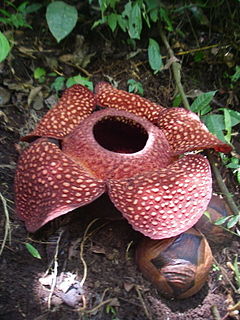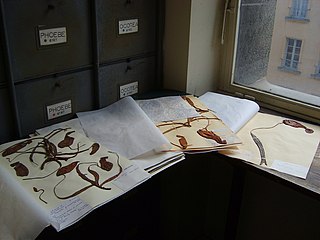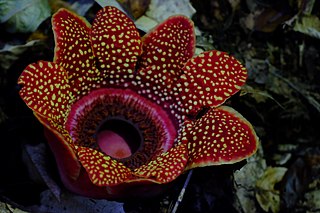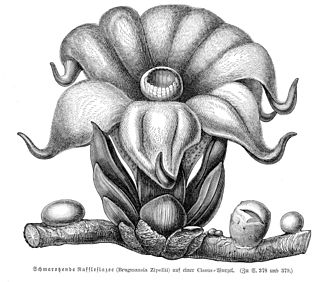
Rafflesia is a genus of parasitic flowering plants in the family Rafflesiaceae. The species have enormous flowers, the buds rising from the ground or directly from the lower stems of their host plants; one species has the largest flowers in the world. The genus contains approximately 28 species, all found in Southeast Asia, mainly in Indonesia, Malaysia, Thailand and the Philippines. For Western Europe, it was first discovered by French surgeon and naturalist Louis Deschamps in Java between 1791 and 1794, but his notes and illustrations, seized by the British in 1803, were not available to western science until 1861. The first British person to see one was Joseph Arnold in 1818, in the Indonesia rainforest in Bengkulu, Sumatra, after a Malay servant working for him discovered a flower and pointed it out to him. It was later named after Stamford Raffles, the leader of the expedition.

A herbarium is a collection of preserved plant specimens and associated data used for scientific study.

Rafflesia arnoldii, the corpse flower or giant padma, is a species of flowering plant in the parasitic genus Rafflesia. It is noted for producing the largest individual flower on Earth. It has a strong and unpleasant odor of decaying flesh. It is native to the rainforests of Sumatra and Borneo. Although there are some plants with larger flowering organs like the titan arum and talipot palm, those are technically clusters of many flowers.

The Rafflesiaceae are a family of rare parasitic plants comprising 36 species in 3 genera found in the tropical forests of east and southeast Asia, including Rafflesia arnoldii, which has the largest flowers of all plants. The plants are endoparasites of vines in the genus Tetrastigma (Vitaceae) and lack stems, leaves, roots, and any photosynthetic tissue. They rely entirely on their host plants for both water and nutrients, and only then emerge as flowers from the roots or lower stems of the host plants.

Sapria is a genus of parasitic flowering plants in the family Rafflesiaceae. It grows within roots of Vitis and Tetrastigma. The genus is limited to the tropical forests of South and Southeast Asia.

Pieter B. Pelser is a Lecturer in Plant Systematics and the curator of the herbarium at the University of Canterbury in Christchurch, New Zealand. One research interest is the evolutionary history of the tribe Senecioneae, one of the largest tribes in the largest family of flowering plants. He wrote the most recent attempt to define and delimit this tribe and its problematic founding species Senecio. He also studies insects that eat these plants (Longitarsus) which contain pyrrolizidine alkaloids and what makes them choose which plants they eat.
Rafflesia philippensis is a parasitic plant species of the Rafflesiaceae family that was named by Francisco Manuel Blanco in his Flora de Filipinas in 1845. The species is known only from a mountain located between the provinces of Laguna and Quezon, Luzon where it was first discovered. Its plant host is Tetrastigma pisicarpum. This species went unnoticed since its first description by Blanco but was rediscovered in 2003 by members of the Tanggol Kalikasan, a local environment conservation group in Quezon province who first saw and photographed the open flower of this species. It was brought to the attention of Manuel S. Enverga University (MSEUF), who formed a team composed of students and faculty to document the newly discovered Rafflesia species.
Rafflesia patma is a parasitic plant species of the genus Rafflesia. It is only known to grow on the Indonesian island of Java, although it may have occurred on Sumatra in the past. Like the other species in its genus, this strange plant has no leaves, stems, roots or even chlorophyll, stealing all its nutrition from Tetrastigma lanceolaurium, a rainforest liana. Instead, the anatomy of this plant has devolved into mere mycelium-like strands of cells infecting the internal vascular system of its host. For general observers, the only time one might know this plant exists at all is when it flowers, and when it does, it does so impressively. The gigantic five-lobed flowers measure 30 to 60cm across, and stink with the odour of rotting flesh. This stench attracts mostly female carrion flies searching for a place to lay their eggs. When they fly inside the large pot-like structure in the middle of the flower, they find a central column inside, topped with a wart-covered disc-like plate; under the rim of this plate they find a small crevice, into which they crawl believing they have found an opening into the soft parts of a rotting body -instead, the rim is shaped in such a way that, when investigating, their backs are thus smeared with the jelly-like pollen if the Rafflesia flower is male, or it is pressed against a zone of modified stigmas if the flower is female.

Rafflesia zollingeriana is a species of flowering plant in the family Rafflesiaceae, native to Java. Of three species of Rafflesia known from Java this species has always been the most rare and restricted, it is only known from collection locales in Banyuwangi Regency, Jember Regency and Lumajang Regency, southern East Java. It was first scientifically collected in 1902 by Sijfert Hendrik Koorders on the eastern flanks of Mount Puger Watangan, a forested hill near the beach, who described it as a new species in 1918. Many decades later a flowering plant was discovered in Meru Betiri National Park, also in the Jember Regency somewhat further down the coast to the east.

Sapria himalayana, commonly known as the hermit's spittoon, is a rare holoparasitic flowering plant related to Rafflesia found in the Eastern Himalayas. Sapria himalayana represents the extreme manifestation of the parasitic mode, being completely dependent on its host plant for water, nutrients and products of photosynthesis which it sucks through a specialised root system called haustoria. These haustoria are attached to both the xylem and the phloem of the host plant.

Suaeda nigra, often still known by the former name Suaeda moquinii, is a species of flowering plant in the amaranth family, known by the vernacular names bush seepweed or Mojave sea-blite.

Rhizanthes is a genus of four species of parasitic flowering plants in the family Rafflesiaceae. They are without leaves, stems, roots, or photosynthetic tissue, and grow within the roots of a few species of Tetrastigma vines. The genus is limited to the tropical forests of Southeast Asia. The flowers of Rhizanthes are very large, they vary from 14 to 43 cm in diameter. At least one species of Rhizanthes, Rh. lowii, is endothermic.
Rhizanthes lowii is a species of parasitic flowering plant without leaves, stems, roots, or photosynthetic tissue. It grows on the roots of the Tetrastigma vine. It includes the specimens with the largest measured flowers in Rhizanthes, from 25 to 43 cm across. They are endothermic, not only producing their own heat, but they also have the rare ability to regulate their own temperature.

Suaeda aegyptiaca is a species of succulent plant in the family Amaranthaceae, and salt-tolerant (halophyte) plant that is distributed in eastern North Africa, the Near East and West Asia.
Alexander Zippelius was a Dutch horticulturalist and botanical collector in the East Indies.
Balanophora is a genus of parasitic plants in the family Balanophoraceae found in parts of tropical and temperate Asia, including the Eastern Himalayas, Malesia region, Pacific Islands, Madagascar, and tropical Africa. There are about 20 accepted species, including the newly discovered B. coralliformis. Many species emit an odour which possibly attracts pollinators in the same way that pollinators are attracted to Rafflesia.

Rafflesia verrucosa was first identified and characterized during a small mammal survey of Mt. Kampalili in eastern Mindanao in 2010. R. verrucosa is the tenth species of Rafflesia found in the Philippines. Rafflesia species have rare and unusual flowers known for their large size and pungent smell. Some plant enthusiasts like Frits W. Went have gone to extreme measures to see these plants in bloom. Went detailed his search for Rafflesia saying,
"I had heard, when I was in Java many years ago, that Rafflesia were to be found on an offshore island named Nusah Kembangan. This was in 1929, when it was a penal colony for major criminals. My driver on this occasion was a convicted murderer, and my guide was serving time for cannibalism."

Protea pudens, also known as the bashful sugarbush, is a low-growing, groundcover-like, flowering shrub in the genus Protea. It is only found growing in the wild in a small area in the Western Cape province of South Africa.

Protea burchellii, also known as Burchell's sugarbush, is a flowering shrub in the genus Protea, which is endemic to the southwestern Cape Region of South Africa.
Zippelia begoniifolia is the only species of the monotypic genus Zippelia, a genus of plants in the Piperaceae, the same botanical family as that of black pepper. The species has also been spelled as Z. begoniaefolia. It is an erect, ascending, perennial herb with leaves of 6 to 12.5 cm in length. It occurs in Borneo, Cambodia, southern-central and southeast mainland China as well as Hainan, Java, Laos, Peninsular Malaysia, the Philippines, Sumatra, Thailand and Vietnam.












